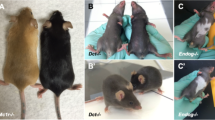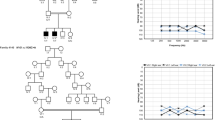Abstract
We describe a protocol for the production of mice carrying N-ethyl-N-nitrosourea (ENU) mutations and their screening for auditory and vestibular phenotypes. In comparison with the procedures describing individual phenotyping tests, this protocol integrates a set of tests for the comprehensive determination of the causes of hearing loss. It comprises a primary screen of relatively simple auditory and vestibular tests. A variety of secondary phenotyping protocols are also described for further investigating the deaf and vestibular mutants identified in the primary screen. The screen can be applied to potentially thousands of mutant mice, produced either by ENU or other mutagenesis approaches. Primary screening protocols take no longer than a few minutes, apart from ABR testing which takes upto 3.5 h per mouse. These protocols have been applied for the identification of mouse models of human deafness and are a key component for investigating the genes and genetic pathways involved in hereditary deafness.
This is a preview of subscription content, access via your institution
Access options
Subscribe to this journal
Receive 12 print issues and online access
$259.00 per year
only $21.58 per issue
Buy this article
- Purchase on Springer Link
- Instant access to full article PDF
Prices may be subject to local taxes which are calculated during checkout











Similar content being viewed by others
References
Brown, S.D., Hancock, J.M. & Gates, H. Understanding mammalian genetic systems: the challenge of phenotyping in the mouse. PLoS. Genet. 2, e118 (2006).
Brown, S.D., Hardisty-Hughes, R.E. & Mburu, P. Quiet as a mouse: dissecting the molecular and genetic basis of hearing. Nat. Rev. Genet. 9, 277–290 (2008).
Brown, S.D. & Hardisty, R.E. Mutagenesis strategies for identifying novel loci associated with disease phenotypes. Semin. Cell Dev. Biol. 14, 19–24 (2003).
Acevedo-Arozena, A. et al. ENU mutagenesis, a way forward to understand gene function. Annu. Rev. Genomics Hum. Genet. 9, 49–69 (2008).
Barbaric, I. et al. An ENU-induced mutation in the Ankrd11 gene results in an osteopenia-like phenotype in the mouse mutant Yoda. Physiol. Genomics 32, 311–321 (2008).
Hough, T.A. et al. Novel mouse model of autosomal semidominant adult hypophosphatasia has a splice site mutation in the tissue nonspecific alkaline phosphatase gene Akp2. J. Bone Miner. Res. 22, 1397–1407 (2007).
Buchner, D.A., Seburn, K.L., Frankel, W.N. & Meisler, M.H. Three ENU-induced neurological mutations in the pore loop of sodium channel Scn8a (Na(v)1.6) and a genetically linked retinal mutation, rd13. Mamm. Genome 15, 344–351 (2004).
Hart, A.W. et al. Genotype-phenotype correlation of mouse pde6b mutations. Invest. Ophthalmol. Vis. Sci. 46, 3443–3450 (2005).
Thaung, C. et al. Novel ENU-induced eye mutations in the mouse: models for human eye disease. Hum. Mol. Genet. 11, 755–767 (2002).
Hough, T.A. et al. Novel phenotypes identified by plasma biochemical screening in the mouse. Mamm. Genome 13, 595–602 (2002).
Inoue, M. et al. A series of maturity onset diabetes of the young, type 2 (MODY2) mouse models generated by a large-scale ENU mutagenesis program. Hum. Mol. Genet. 13, 1147–1157 (2004).
Bacon, Y. et al. Screening for novel ENU-induced rhythm, entrainment and activity mutants. Genes. Brain Behav. 3, 196–205 (2004).
Beckers, J., Wurst, W. & de Angelis, M.H. Towards better mouse models: enhanced genotypes, systemic phenotyping and envirotype modelling. Nat. Rev. Genet. (2009).
Sharpe, J. et al. Optical projection tomography as a tool for 3D microscopy and gene expression studies. Science 296, 541–545 (2002).
Mackenzie, F. et al. Analysis of the mouse mutant Cloth-ears shows a role for the voltage-gated sodium channel Scn8a in peripheral neural hearing loss. Genes Brain Behav. 8, 699–713 (2009).
Justice, M.J. et al. Effects of ENU dosage on mouse strains. Mamm. Genome 11, 484–488 (2000).
Tsai, H. et al. The mouse slalom mutant demonstrates a role for Jagged1 in neuroepithelial patterning in the organ of Corti. Hum. Mol. Genet. 10, 507–512 (2001).
Rogers, M.J. et al. Genetic mapping of the whirler mutation. Mamm. Genome 10, 513–519 (1999).
Rogers, D.C. et al. Behavioral and functional analysis of mouse phenotype: SHIRPA, a proposed protocol for comprehensive phenotype assessment. Mamm. Genome 8, 711–713 (1997).
Sawada, I., Kitahara, M. & Yazawa, Y. Swimming test for evaluating vestibular function in guinea pigs. Acta. Otolaryngol. Suppl. 510, 20–23 (1994).
Nolan, P.M. et al. A systematic, genome-wide, phenotype-driven mutagenesis programme for gene function studies in the mouse. Nat. Genet. 25, 440–443 (2000).
Zheng, Q.Y., Johnson, K.R. & Erway, L.C. Assessment of hearing in 80 inbred strains of mice by ABR threshold analyses. Hear. Res. 130, 94–107 (1999).
Jewett, D.L. & Romano, M.N. Neonatal development of auditory system potentials averaged from the scalp of rat and cat. Brain Res. 36, 101–115 (1972).
Buchwald, J.S. & Huang, C. Far-field acoustic response: origins in the cat. Science 189, 382–384 (1975).
Huang, C.M. & Buchwald, J.S. Interpretation of the vertex short-latency acoustic response: a study of single neurons in the brain stem. Brain Res. 137, 291–303 (1977).
Brown, S.D., Chambon, P. & de Angelis, M.H. EMPReSS: standardized phenotype screens for functional annotation of the mouse genome. Nat. Genet. 37, 1155 (2005).
Hardisty-Hughes, R.E. et al. A mutation in the F-box gene, Fbxo11, causes otitis media in the Jeff mouse. Hum. Mol. Genet. 15, 3273–3279 (2006).
Zheng, Q.Y., Hardisty-Hughes, R. & Brown, S.D. Mouse models as a tool to unravel the genetic basis for human otitis media. Brain Res. 1091, 9–15 (2006).
Hardisty, R.E. et al. The deaf mouse mutant Jeff (Jf) is a single gene model of otitis media. J. Assoc. Res. Otolaryngol. 4, 130–138 (2003).
Parkinson, N. et al. Mutation at the Evi1 locus in Junbo mice causes susceptibility to otitis media. PLoS Genet. 2, e149 (2006).
Rhodes, C.R. et al. The homeobox gene Emx2 underlies middle ear and inner ear defects in the deaf mouse mutant pardon. J. Neurocytol. 32, 1143–1154 (2003).
Steel, K.P., Barkway, C. & Bock, G.R. Strial dysfunction in mice with cochleo-saccular abnormalities. Hear Res. 27, 11–26 (1987).
Holme, R.H., Kiernan, B.W., Brown, S.D. & Steel, K.P. Elongation of hair cell stereocilia is defective in the mouse mutant whirler. J. Comp. Neurol. 450, 94–102 (2002).
Erven, A. et al. A novel stereocilia defect in sensory hair cells of the deaf mouse mutant Tasmanian devil. Eur. J. Neurosci. 16, 1433–1441 (2002).
MacArthur, C.J., Hefeneider, S.H., Kempton, J.B. & Trune, D.R. C3H/HeJ mouse model for spontaneous chronic otitis media. Laryngoscope 116, 1071–1079 (2006).
Zheng, Q.Y., Tong, Y.C., Alagramam, K.N. & Yu, H. Tympanometry assessment of 61 inbred strains of mice. Hear. Res. 231, 23–31 (2007).
Smith, A.P. et al. Analysis of breeding and pathology helps refine management practices of a large-scale N′-ethyl-N′-nitrosourea mouse mutagenesis programme. Lab. Anim. 43, 1–10 (2009).
Acknowledgements
This work was supported by the MRC and FP6 Integrated Project EUROHEAR, LSHG-CT-2004-512063. We thank Steve Thomas and Kevin Glover for figure preparation.
Author information
Authors and Affiliations
Contributions
R.E.H.-H. and S.D.M.B. designed the pipeline; R.E.H.-H. and A.P. carried out experimental work utilizing the pipeline; and R.E.H.-H., A.P. and S.D.M.B. wrote the paper.
Corresponding author
Rights and permissions
About this article
Cite this article
Hardisty-Hughes, R., Parker, A. & Brown, S. A hearing and vestibular phenotyping pipeline to identify mouse mutants with hearing impairment. Nat Protoc 5, 177–190 (2010). https://doi.org/10.1038/nprot.2009.204
Published:
Issue Date:
DOI: https://doi.org/10.1038/nprot.2009.204
This article is cited by
-
The proper timing of Atoh1 expression is pivotal for hair cell subtype differentiation and the establishment of inner ear function
Cellular and Molecular Life Sciences (2023)
-
Gene therapy via canalostomy approach preserves auditory and vestibular functions in a mouse model of Jervell and Lange-Nielsen syndrome type 2
Nature Communications (2021)
-
Insights into phenotypic differences between humans and mice with p.T721M and other C-terminal variants of the SLC26A4 gene
Scientific Reports (2021)
-
Epistasis regulates the developmental stability of the mouse craniofacial shape
Heredity (2019)
-
High-throughput mouse phenomics for characterizing mammalian gene function
Nature Reviews Genetics (2018)
Comments
By submitting a comment you agree to abide by our Terms and Community Guidelines. If you find something abusive or that does not comply with our terms or guidelines please flag it as inappropriate.



